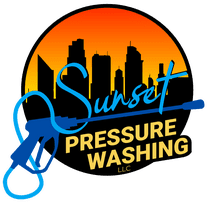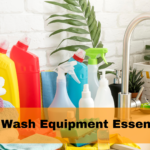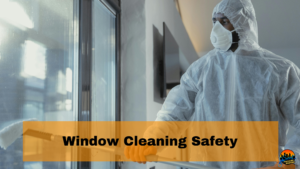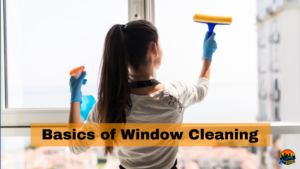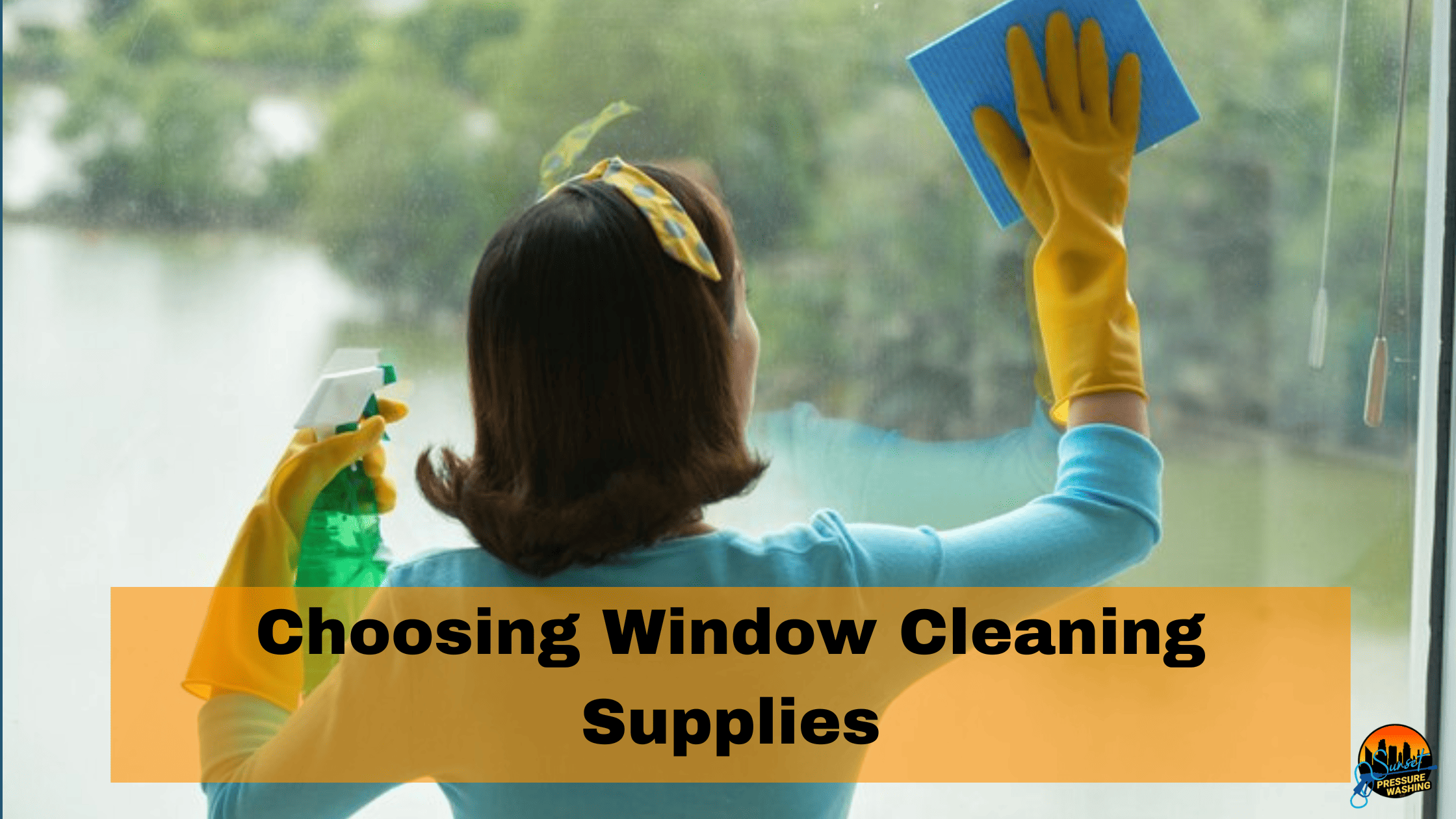
Choosing Window Cleaning Supplies
Keeping your windows clean is not just about the sparkle; it’s also about preserving the integrity of the glass and enjoying unobstructed views of your surroundings. Whether you’re a DIY enthusiast or a professional looking to restock your supplies, selecting the right tools is crucial. Here’s a comprehensive guide to help you make the best choices for your window cleaning needs.
Understanding the Basics
The Core Tools for Effective Window Cleaning
- Squeegee: The squeegee is the star of the window cleaning world. A good squeegee has a sharp, flexible rubber blade that removes water and cleaning solution from the glass, leaving it dry and streak-free. The key is to find one that fits comfortably in your hand and has replaceable blades.
- Scrubber or Sponge: Before you can squeegee the window, you need to loosen and remove the dirt. A scrubber, sometimes called a window mop, is used for this purpose. It’s essentially a sponge or cloth covered with a durable, absorbent material designed to hold water and cleaning solution as it glides across the glass surface.
- Cleaning Solution: The choice of cleaning solution can vary from simple to sophisticated. Many professionals swear by a simple mix of water and a small amount of dish soap. This solution is effective at cutting through grease and dirt without leaving streaks or harming the window’s surface.
- Bucket: A large bucket is necessary to hold the cleaning solution. It should be big enough to easily dip your scrubber or sponge into without spilling.
- Lint-Free Cloths or Towels: After using the squeegee, there may still be small areas of water left on the edges or corners of the window. Lint-free cloths are perfect for wiping these areas dry without leaving behind any residue or fibers.
- Ladder (for High Windows): Safety should be your top priority, especially when cleaning windows that are out of reach from the ground. A sturdy ladder that reaches your highest window comfortably is essential. Always ensure it is secure and stable before climbing.
Techniques for a Spotless Finish
- Pre-Clean: Before applying any water or solution, remove loose dirt and debris from the window frame and sill. This prevents any dirt from turning into mud when wet and ensures a cleaner finish.
- Wet the Window: Dip your scrubber into the cleaning solution, squeeze out the excess water, and then apply it to the window. Scrub the entire surface to loosen the dirt.
- Squeegee Technique: Starting at the top corner of the window, tilt the squeegee so only one corner touches the glass. Move it across the window in a smooth, steady motion. After each pass, wipe the squeegee blade with a clean cloth to remove excess water and dirt. Continue this process, overlapping each stroke slightly until you’ve covered the entire window.
- Detailing Edges: Use a clean, lint-free cloth to wipe away any remaining water or streaks along the edges and corners of the window.
- Regular Maintenance: Keeping your windows clean is an ongoing task. Regular maintenance not only enhances the appearance of your property but also extends the life of your windows by preventing the buildup of harmful substances.
Choosing the Right Squeegee
Selecting the perfect squeegee is a pivotal step in ensuring your window cleaning efforts yield flawless, streak-free results. The squeegee, with its rubber blade, is the tool that directly impacts the cleanliness and clarity of your windows. Here’s how to choose a squeegee that will meet your needs and help you achieve professional-quality window cleaning.
Key Factors in Choosing a Squeegee
1. Blade Material
The heart of a squeegee is its blade. Most high-quality squeegees come with a rubber blade, which offers the perfect balance of flexibility and rigidity to remove cleaning solution and water from the glass efficiently. Natural rubber blades are preferred for their durability and effectiveness in leaving a clean, streak-free surface. Some squeegees also offer synthetic or silicone blades, which can be more resistant to wear and chemicals but may not provide the same level of performance on all types of glass.
2. Blade Replacement
Look for a squeegee that allows for easy blade replacement. The ability to quickly and easily change the blade extends the life of the squeegee and ensures optimal performance. Over time, blades can become dull, nicked, or warped, which can lead to streaking and inefficient cleaning. Having a squeegee that lets you swap out blades means you can always maintain a sharp, effective edge.
3. Handle Comfort and Length
The handle of the squeegee should feel comfortable in your hand, as you’ll be using it extensively. Ergonomic designs can reduce hand fatigue and improve control. Additionally, consider the length of the handle. While a shorter handle offers more precision and is ideal for smaller windows, a longer handle can extend your reach on larger windows or areas that are slightly out of reach. Some squeegees come with telescopic handles or the option to attach an extension pole, which is particularly useful for high windows.
4. Squeegee Size and Shape
Squeegees come in various sizes, ranging from small, handheld models to large, professional-grade tools. The size you choose should correspond to the most common size of the windows you’ll be cleaning. Using a squeegee that’s too large for a small window can be cumbersome, while a small squeegee on a large window can be inefficient and time-consuming. Additionally, consider the shape of the squeegee. Some models have straight edges, while others have a slight curve. The straight-edge squeegees are versatile and work well on most windows, whereas curved-edge squeegees can better adapt to the shape of the glass, offering a closer clean on rounded windows.
5. Channel Material and Design
The channel holds the rubber blade in place and can be made from various materials, including stainless steel, brass, and plastic. Stainless steel and brass are durable and resist rust and corrosion, making them ideal for professional use or in humid environments. Plastic channels are lighter and can be less intimidating for beginners but may not offer the same level of durability and precision as metal options.
Selecting a Scrubber
When it comes to window cleaning, the scrubber plays a pivotal role in loosening and removing dirt, grime, and other residues from the glass. Selecting the right scrubber is just as important as choosing the perfect squeegee, as it directly impacts the effectiveness of your cleaning process. Here are essential factors to consider when picking a scrubber for your window cleaning needs.
Considerations for Choosing the Right Scrubber
1. Material and Durability
Scrubbers are typically made from a range of materials, including microfiber, synthetic fabrics, and natural fibers. Microfiber is a popular choice due to its ability to trap dirt effectively and its gentle nature on glass surfaces. Regardless of the material, durability is key. The scrubber should withstand repeated use and washing, especially if you’re cleaning windows frequently or professionally.
2. Size and Shape
Scrubbers come in various sizes and shapes, designed to accommodate different window sizes and cleaning styles. For larger windows, a bigger scrubber can save time and effort by covering more surface area with each pass. Conversely, smaller windows or those with panes may benefit from a compact scrubber that can navigate tight spaces more easily. Some scrubbers are shaped or angled to better reach corners and edges, making your cleaning process more efficient.
3. Absorbency
A good scrubber should hold enough water and cleaning solution to wet the window effectively without the need for constant re-soaking. High absorbency ensures that you can clean larger areas before needing to dip the scrubber back into your cleaning solution. This feature is particularly important when working on outdoor windows or in sunny conditions where the solution may evaporate quickly.
4. Ease of Cleaning
After the job is done, you’ll need to clean the scrubber itself. Look for scrubbers that are machine washable or easy to rinse out by hand. This not only maintains the hygiene of your cleaning tools but also extends the life of the scrubber by preventing the buildup of dirt and grime.
5. Handle Attachment
Some scrubbers come with a handle, while others are designed to attach to a pole or have an integrated grip. A handle can offer more control and reduce hand fatigue, especially when cleaning for extended periods. If you’re dealing with high windows, a scrubber that attaches to an extension pole is a must. This allows you to clean safely from the ground without the need for ladders.
The Ideal Cleaning Solution
Choosing the ideal cleaning solution for your windows is not just about achieving that perfect streak-free shine; it’s also about ensuring the safety of your windows, your health, and the environment. A good cleaning solution will effectively remove dirt, grease, and grime without damaging the glass or leaving behind harmful residues. Let’s explore how to select or create the perfect window cleaning solution for sparkling results.
Commercial vs. Homemade Cleaning Solutions
Commercial Cleaning Solutions
Commercial window cleaners are widely available and offer convenience and effective cleaning power. When selecting a commercial cleaner, look for products specifically designed for windows to avoid streaks and residues. Consider environmentally friendly options that use natural ingredients and avoid harsh chemicals, which are better for both the environment and indoor air quality.
Pros:
- Cost-effective and easy to make
- Non-toxic and environmentally friendly
- Ingredients are readily available and safe for most window types
Cons:
- Description: Provides a wider spray, which distributes pressure over a larger area.
- Uses: Great for general cleaning tasks like decks, sidewalks, and driveways. It’s effective yet gentle enough to prevent damage to wood and other softer surfaces.
Tips for Using Cleaning Solutions
- Test First: If you’re trying a new cleaning solution, commercial or homemade, test it on a small, inconspicuous area of the window to ensure it doesn’t cause any damage or leave streaks.
- Use the Right Amount: Too much soap or vinegar in your solution can leave residue. Start with a small amount and adjust as needed.
- Choose the Right Cloth: Use a lint-free cloth, microfiber towel, or squeegee to apply and remove the cleaning solution. These tools help avoid streaks and ensure a clean finish.
- Consider the Weather: Avoid cleaning windows in direct sunlight or on very hot days, as the solution can dry too quickly and leave streaks.
- Regular Maintenance: Keeping up with regular cleaning can prevent the buildup of tough grime, making it easier to maintain your windows with your chosen solution.
Microfiber Towels: A Must-Have
Microfiber towels have revolutionized cleaning practices across the globe, becoming an indispensable tool in the window cleaning arsenal. Their unique composition and superior cleaning capabilities make them a must-have for anyone looking to achieve sparkling, streak-free windows. Here’s why microfiber towels stand out and how you can use them to enhance your window cleaning routine.
What Makes Microfiber Towels Special?
- Superior Absorbency Microfiber is made from a blend of polyester and polyamide, woven into a fabric with millions of tiny fibers. This structure allows microfiber towels to absorb up to seven times their weight in water, making them perfect for drying windows after washing. Unlike traditional cloths that may leave streaks or not fully absorb water, microfiber towels ensure a dry, streak-free finish.
- Lint-Free Cleaning One of the most frustrating aspects of window cleaning is dealing with lint left behind by conventional towels. Microfiber towels are lint-free, meaning they won’t leave any residues that could obscure your windows’ clarity. This feature is particularly beneficial for cleaning glass surfaces, where even the smallest fibers can be noticeable.
- Durability Microfiber towels are not only effective but also durable. They can withstand hundreds of washes when cared for properly, making them an eco-friendly and cost-effective choice. Unlike paper towels or less durable cloths that might tear or degrade over time, microfiber towels maintain their integrity and cleaning power through extensive use.
- Versatility Microfiber towels are incredibly versatile and can be used for a variety of tasks beyond just drying windows. They’re effective for dusting, polishing, and even cleaning other surfaces like countertops, mirrors, and stainless steel. Having a set of microfiber towels on hand means you’re equipped for a wide range of cleaning challenges.
- Chemical-Free Cleaning Thanks to their fine fibers and electrostatic properties, microfiber towels can trap dirt, dust, and grime more effectively than traditional cloths. This means you can often clean effectively with just water, reducing the need for chemical cleaners. For those seeking a more environmentally friendly and health-conscious approach to cleaning, microfiber towels are an ideal choice.
How to Use Microfiber Towels for Window Cleaning
- Drying: After washing your windows with a scrubber and squeegee, use a clean, dry microfiber towel to wipe away any remaining moisture from the glass, frames, and sill.
- Polishing: To remove any streaks or water spots, fold the microfiber towel into quarters for a fresh surface and gently buff the glass in a circular motion.
- Touch-ups: Keep a microfiber towel handy for quick touch-ups on fingerprints or smudges. The electrostatic properties help to lift grease and oil without smearing.
Care and Maintenance
To keep your microfiber towels in top condition, wash them separately from other laundry to avoid picking up lint. Use a gentle, bleach-free detergent and skip the fabric softener, as it can clog the fibers and reduce their effectiveness. Air drying or using a low heat setting in the dryer will help maintain their absorbency and softness. Incorporating microfiber towels into your window cleaning routine is a simple yet effective way to ensure your windows remain spotlessly clean. With their superior cleaning abilities and environmental benefits, it’s clear why microfiber towels are a must-have for professionals and DIY cleaners alike.
Extension Poles for Hard-to-Reach Windows
When it comes to cleaning windows, one of the biggest challenges can be reaching those high or awkwardly placed panes that seem just out of arm’s reach. This is where extension poles become invaluable tools in your window cleaning arsenal. Not only do they help you safely clean hard-to-reach windows, but they also significantly reduce the time and effort required to achieve a sparkling finish. Here’s how to select and utilize extension poles for your window cleaning tasks.
The Benefits of Using Extension Poles
- Safety First The primary advantage of using an extension pole is the increased safety it offers. Instead of risking a fall by climbing ladders or stretching beyond your balance, an extension pole allows you to keep both feet firmly on the ground while reaching those elevated windows.
- Increased Reach and Efficiency With an extension pole, you can easily clean high windows, skylights, or transom windows without the need for scaffolding or ladders. This not only makes the job quicker but also allows for more frequent cleaning, as the hassle and risks associated with accessing these windows are minimized.
- Versatility Many extension poles come with attachments or can be fitted with various tools, such as squeegees, scrubbers, and brushes. This versatility means you can complete the entire cleaning process—from washing to drying—without changing tools or climbing up and down to adjust your equipment.
Choosing the Right Extension Pole
- Length Extension poles come in a range of lengths, typically from about 4 feet to over 30 feet. The ideal length depends on the height of the windows you plan to clean. It’s wise to choose a pole slightly longer than your maximum reach requirement to ensure you’re not stretching uncomfortably at its fullest extension.
- Material The material of the pole affects its weight and durability. Aluminum poles are lightweight and easy to handle, making them a popular choice for most residential and light commercial tasks. Fiberglass poles offer more strength and are better suited for heavy-duty or professional use, especially when extended to longer lengths.
- Locking Mechanism A reliable locking mechanism is crucial to ensure the pole stays extended at the desired length securely. Look for poles with either twist-and-lock or lever-lock mechanisms, as these tend to offer the best balance of ease of use and security.
- Compatibility Consider the compatibility of the extension pole with your existing cleaning tools. Some poles are designed to work with specific brands or types of attachments, so it’s important to ensure that your tools can be easily fitted to the pole you choose.
Safety Equipment
Ensuring safety while cleaning windows, especially those that are high or difficult to access, is paramount. While extension poles can reduce the need for ladders or scaffolding, there are still situations where their use is unavoidable. In such cases, having the right safety equipment is not just a precaution—it’s a necessity. Here’s a breakdown of the essential safety equipment you should consider to protect yourself during window cleaning tasks.
Ladders
Choosing the right ladder is the first step in safe window cleaning. Opt for a ladder that is sturdy and appropriate for the height you need to reach. There are several types to consider:
- Step Ladders: Ideal for indoor use or lower outdoor windows, providing stability and ease of use.
- Extension Ladders: Suitable for higher windows, these ladders can be adjusted to various lengths. Ensure they have non-slip feet and are set at the correct angle (the 1:4 rule—1 foot away from the building for every 4 feet in height).
- Multi-Purpose Ladders: These versatile ladders can be converted into step ladders, extension ladders, or scaffolding, providing flexibility for different tasks.
Non-Slip Shoes
Footwear is often overlooked when it comes to window cleaning safety. Shoes with non-slip soles are essential, especially when working on ladders or in wet conditions. They provide the grip needed to reduce the risk of slips and falls.
Safety Harnesses
For jobs that involve working at significant heights or in precarious positions, a safety harness can be a lifesaver. When anchored securely, a harness will prevent a fall or minimize injury if a slip occurs. Ensure the harness fits correctly and is used in accordance with manufacturer instructions.
Gloves
Wearing gloves can provide both grip and protection. When handling wet tools or working in cold conditions, gloves can help maintain dexterity and comfort. Choose gloves that offer grip without sacrificing sensitivity or control.
Protective Eyewear
Cleaning solutions, even eco-friendly or homemade mixtures, can cause irritation or injury if they come into contact with your eyes. Protective eyewear shields against splashes, as well as dust and debris dislodged during cleaning.
First-Aid Kit
Always have a first-aid kit nearby when undertaking window cleaning tasks. The kit should include basics like band-aids, antiseptic wipes, and bandages, ensuring you can quickly address any minor injuries that occur.
Safety Tips for Window Cleaning
- Inspect Equipment: Before each use, inspect ladders, harnesses, and other safety equipment for wear, damage, or defects.
- Be Mindful of Weather Conditions: Avoid window cleaning in adverse weather conditions, such as high winds or rain, which can increase the risk of accidents.
- Clear the Area: Ensure the area around your workspace is clear of obstacles that could cause trips or interfere with ladder placement.
- Use Proper Techniques: Always climb and descend ladders facing them, keeping three points of contact (two hands and one foot, or two feet and one hand) at all times.
- Work with a Buddy: Whenever possible, have someone with you when cleaning high or hard-to-reach windows. We can help stabilize the ladder and provide assistance in case of an emergency.
Eco-Friendly Options
In the realm of window cleaning, eco-friendly options not only contribute to a healthier environment but also ensure the safety of those using them and living in the spaces being cleaned. Embracing sustainable practices in window cleaning involves choosing biodegradable cleaning solutions, utilizing tools made from sustainable materials, and adopting methods that minimize waste. Here’s a guide to making your window cleaning routine more environmentally friendly.
1. Biodegradable Cleaning Solutions
One of the simplest ways to adopt eco-friendly window cleaning practices is to use biodegradable cleaning solutions. These solutions break down naturally in the environment, reducing the risk of harm to waterways, soil, and wildlife. Many eco-friendly cleaning solutions can be made at home using ingredients like vinegar, which is effective at cutting through grime and leaving a streak-free finish, and water. A popular recipe involves mixing equal parts of white vinegar and water. For tougher jobs, a few drops of eco-friendly dish soap can be added to the mixture.
2. Reusable, Washable Cloths
Microfiber cloths are an excellent choice for eco-friendly window cleaning. Not only do they effectively clean and polish glass surfaces without the need for chemical cleaners, but they are also washable and reusable, significantly reducing waste. When these cloths eventually wear out, consider options made from recycled materials for replacement.
3. Sustainable Tools
Opt for window cleaning tools made from sustainable materials. Handles made from bamboo or recycled plastics, and squeegees with replaceable rubber blades, ensure you’re not contributing to the cycle of waste. These tools often have the added benefit of being more durable, meaning you’ll replace them less frequently.
4. Water Conservation
Water conservation is another aspect of eco-friendly window cleaning. Using a bucket of water rather than a running hose to rinse windows can significantly reduce water usage. Additionally, water-fed pole systems, which are particularly useful for cleaning exterior windows, can be adjusted to use only the necessary amount of water, minimizing waste.
5. Recycled and Recyclable Packaging
When purchasing window cleaning solutions or tools, look for products with minimal packaging, preferably made from recycled materials. Also, consider whether the packaging is recyclable in your area. This mindfulness in purchasing decisions can have a substantial impact on reducing your carbon footprint.
Specialized Tools for Specific Needs
In the realm of window cleaning, certain scenarios call for specialized tools beyond the standard squeegee and scrubber. These tools are designed to tackle unique challenges, such as stubborn stains, hard-to-reach areas, or specific types of debris. Incorporating these specialized tools into your window cleaning kit can significantly enhance the efficiency and effectiveness of your cleaning routine.
1. Water-Fed Pole Systems
Water-fed pole systems are a game-changer for cleaning exterior windows, especially those that are high or difficult to access. These systems use a pole equipped with a brush and a water supply system that pumps purified water onto the window while the brush scrubs away dirt. The purified water dries spot-free, eliminating the need for squeegeeing. This not only improves safety by reducing the need for ladders but also ensures a streak-free finish without the use of chemical cleaners.
2. Glass Scrapers
Glass scrapers are invaluable for removing stubborn substances from windows, such as paint overspray, bird droppings, or tree sap. Equipped with a sharp blade, a scraper can cleanly remove these materials without damaging the glass. It’s crucial to use scrapers carefully, ensuring the glass is wet and checking the blade for any burrs that could scratch the window.
3. Telescopic Window Cleaning Brushes
For those who prefer not to use water-fed pole systems, telescopic window cleaning brushes offer an alternative for reaching high windows. These brushes can be attached to a garden hose, allowing water to flow through as you scrub. While they don’t offer the same purified water benefits as water-fed systems, they still provide an effective solution for extending your reach.
4. Microfiber Window Wands
For those who prefer not to use water-fed pole systems, telescopic window cleaning brushes offer an alternative for reaching high windows. These brushes can be attached to a garden hose, allowing water to flow through as you scrub. While they don’t offer the same purified water benefits as water-fed systems, they still provide an effective solution for extending your reach.
5. Angle Adapters
When dealing with windows that are set at an angle or have deep sills, standard tools may not reach effectively. Angle adapters can be attached to your squeegee or scrubber handle, allowing you to adjust the angle of the tool head. This ensures full contact with the glass surface, even in tricky spots.
6. Extension Pole Accessories
A variety of accessories can be attached to extension poles to enhance their functionality. For example, a cobweb brush can help clear away debris and spider webs from around windows before you start cleaning. Similarly, a utility hook can assist in opening hard-to-reach windows from the ground.
Maintenance and Storage
Proper maintenance and storage of your window cleaning supplies are crucial for extending their lifespan and ensuring they remain effective and safe to use. Neglecting these aspects can lead to damaged equipment, decreased efficiency, and even safety hazards. Here’s a guide to keeping your window cleaning tools in top condition.
1. Cleaning Your Tools After Use
One of the simplest yet most important steps in maintenance is cleaning your tools after each use. This includes rinsing your squeegee blade, scrubber, and any brushes or microfiber cloths you’ve used. Removing dirt, grime, and cleaning solution residues prevents the buildup of bacteria and extends the life of the materials. For squeegee blades and rubber components, avoid using harsh chemicals that can cause them to deteriorate faster.
2. Inspecting for Wear and Tear
For those who prefer not to use water-fed pole systems, telescopic window cleaning brushes offer an alternative for reaching high windows. These brushes can be attached to a garden hose, allowing water to flow through as you scrub. While they don’t offer the same purified water benefits as water-fed systems, they still provide an effective solution for extending your reach.
3. Proper Drying Before Storage
Ensure all tools are thoroughly dried before storing them to prevent mold and mildew growth, especially on items like scrubbers and microfiber cloths. Hang cloths and mop heads in a well-ventilated area or outdoors if weather permits. Keeping rubber components of squeegees away from direct sunlight and heat sources can prevent them from cracking and aging prematurely.
4. Storing Tools in a Dry, Organized Manner
Select a storage area that is dry and protected from extreme temperatures to keep your window cleaning supplies in good condition. Organize your tools in a way that prevents them from becoming damaged or tangled. Hanging larger tools, such as extension poles and squeegees, can save space and protect their integrity. Smaller items like scrapers and clothes can be stored in bins or drawers, sorted by type for easy access.
5. Replacing Components as Needed
Don’t hesitate to replace parts of your tools when they show significant wear or no longer perform as expected. Squeegee blades, for instance, are relatively inexpensive and easy to replace but can make a big difference in cleaning results. Keeping spare parts on hand can save time and ensure you always have what you need for efficient window cleaning.
When DIY Isn't Enough: Meet Sunset Pressure Wash
While having the right tools and supplies is crucial for keeping your windows clean, sometimes the task requires a professional touch. Whether it’s due to the height, the extent of the dirt, or simply the lack of time, Sunset Pressure Wash is here to help. Offering a range of cleaning services, including window cleaning, pressure washing, and more, Sunset Pressure Wash ensures your home or business looks its best. With a focus on quality, safety, and customer satisfaction, you can trust Sunset Pressure Wash to handle all your cleaning needs. Visit Sunset Pressure Wash today to learn more about our services and how we can help you achieve sparkling clean windows without the hassle.
